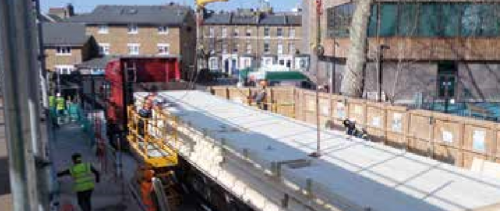Design for Manufacture and Assembly (DfMA) is critical to the future success of offsite technology and a new breed of construction thinking - but is it really that new? Sarah Newine Moore, Project Manager at Eurban, illustrates a tale of two design methodologies.
In 1948 the industrial engineer and educator Geoffrey Boothroyd started his career as an apprentice in the Mather and Platt factory in Manchester. He would have worked with some of the figures immortalised in LS Lowry's paintings. This factory, a major employer in Manchester, produced mainly large centrifugal pumps. It was there that Boothroyd gained his insight into industrial production lines.
By the 1970s, such production lines were radically changing and Boothroyd was teaching in the University of Massachusetts. His team's research aimed to provide designers with tools to drive efficiencies in automatic and manual assembly of products in factories. This research built upon other contemporary studies in European Universities and industry. Boothroyd and his team's work resulted in a piece of software: Design for (Automatic and Manual) Assembly (DFA) for the Apple II Plus.

Two of the world's biggest companies, Ford and General Motors, claimed to have saved billions by adopting DFA, and interest in this design methodology grew exponentially. Boothroyd Dewhurst Inc. was established in 1983 and the team developed their next tool for designers: Design for Manufacture (DFM). This additional module of the software enabled a series of design options that could be accurately costed prior to manufacture, allowing for further efficiencies on the production line. Accompanying the development of the DFM and DFA software came to the publication - Product Design for Manufacture and Assembly - and so the term Design for Manufacture and Assembly (DfMA) was born.
DfMA is the combination of the two design methodologies: DFM (the design of individual parts of an assembly) and DFA (how to assemble all the parts to make the final product.) The core principles of DFM are to simplify the design of a product by reducing the number of constituent parts, and by selecting the most cost-effective materials and processes in their manufacture. While DFA aims to minimise the number of operations and therefore reduce assembly time and cost of a product.
The success of the DfMA design methodology has led to its adoption across a wide range of professions including the construction industry in the UK. In the construction industry, DfMA relates to the prefabrication of building elements offsite in controlled factory environments for onsite assembly, enabling efficiencies in time, labour and cost.
DfMA in UK Today RIBA published the DfMA overlay to the RIBA Plan of Work in 2016. One of the key recommendations is to front-load the design process by bringing specialist subcontractors and consultants on board as early as stage 2 in order to discuss buildability from the outset. This requires a significant shift away from more traditional forms of design and procurement. The industry still has a long way to go in this regard as the Farmer Review of the Construction Labour Model made clear - declaring in its title that the industry needs to 'Modernise or Die'. Among the recommendations outlined in the Farmer Review are 'premanufactured approaches' - such as CLT/solid timber structures.

DfMA methodology is integral to the design, manufacture and assembly of solid timber buildings and to how we work at Eurban. Ten years ago Eurban completed the installation of Waingels College, designed by Sheppard Robson. The term DfMA with reference to construction was not yet fully in use, however, the adoption of earlier versions of the CAD/CAM software still used by Eurban today, enabled structural design options to be explored, agreed and integrated into the project. The architects coordinated and signed off the drawings produced, and these were then manufactured by the factory offsite.
Fast forward eight years to 2017. Eurban now adopts far more sophisticated software and more rigorous QA processes to deliver projects. Two recently completed buildings, Highpoint Terrace, a large eight-storey residential block in central London, and Frilford Golf club in Oxfordshire both employed advanced 3D BIM to develop the most efficient designs in terms of manufacture in the factory and assembly onsite.
During the design phase of Highpoint Terrace, Eurban's specialist timber engineers designed the most efficient structural solution, significantly reducing the number of elements by designing large 16m floor panels. A reduced number of operations onsite should lead to increased safety. 25% less labour was required to assemble this building, only eight site operatives as opposed to 35 if it had been a concrete structure. DfMA hand-inhand with BIM enables much better risk management.
4DBIM gives design teams the opportunity to develop the DfMA methodology one step further. Both projects introduced the fourth dimension to the BIM models - time. The entire solid timber superstructure assembly can be modelled before work begins onsite. Crane locations and lifts, material set down areas, deliveries, and labour requirements can all be mapped out and communicated to the design team. This brings real advantages: sequencing issues and risks can be identified and addressed earlier, giving stakeholders and clients a high degree of insight and control over the process.
The Future of DfMA
The continued use and improvement of DfMA design methodologies should enable projects to become more efficient and enable government targets in the sector for greater productivity and lower emissions to be met. The solid timber industry continues to grow in this country, in Europe and globally. New production plants are opening for business all over the world while existing plants are increasing their capacity by extending and opening new sites.
DfMA may require higher expenditure earlier in the design phase due to fees for specialists, but this early expenditure leads to greater predictability and therefore pays off during the build phase. When client bodies understand the longer term gain of early investment their projects should reap the benefits.
For more information visit: www.eurban.co.uk









